The Kawasaki Heavy Industries Group is promoting its Group Vision 2030, “Trustworthy Solutions for the Future,” as its vision for the future by 2030. The three key persons leading the Kawasaki Heavy Industries Group speak on the theme of the focus fields that will be realized by robots.
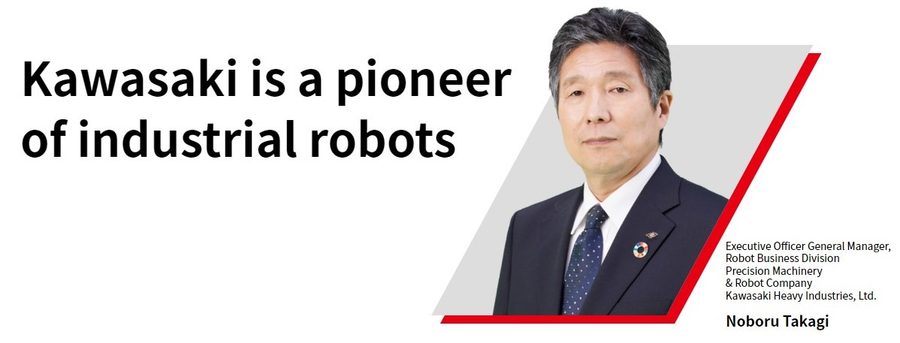
Kawasaki Heavy Industries was Japan’s first industrial robot manufacturer and has been working with robots for more than 50 years. As the demand for robots rises due to the coronavirus crisis, what direction is the company heading in? How will the new “Nyokkey,” “Kaleido,” and “ROBO CROSS” initiatives of Kawasaki contribute to the social implementation of robots? We interviewed General Manager Noboru Takagi of the Robot Business Division of the Kawasaki Heavy Industries Precision Machinery & Robot Company.
ー As we discuss the vision for the future, let us first look back at the history of Kawasaki.
Noboru Takagi:
In 1969, Kawasaki established itself as Japan’s first industrial robot manufacturer through a technical collaboration with Unimation of the United States.
Initially, we mainly developed robots for automobile manufacturing, and when automobile manufacturers expanded overseas in around 1990, Kawasaki also started operations overseas.
In around 1995, we started to develop a new clean robot specifically for the handling of semiconductor wafers and liquid crystal displays. The automotive and semiconductor industries are still a major part of our business.
However, we are also actively working on new industries. In 2013, we entered the healthcare industry by establishing Medicaroid as a joint venture with the medical device manufacturer SYSMEX. Our surgery supporting robot “hinotori™” has already been used in more than 100 cases.
In 2015, we also launched duAro, a dual-arm SCARA robot based on the concept of a “human- collaborative robot” that can perform work together with people.
Looking back, I feel that it has been 50 years where we were constantly opening up new paths for industrial robots.
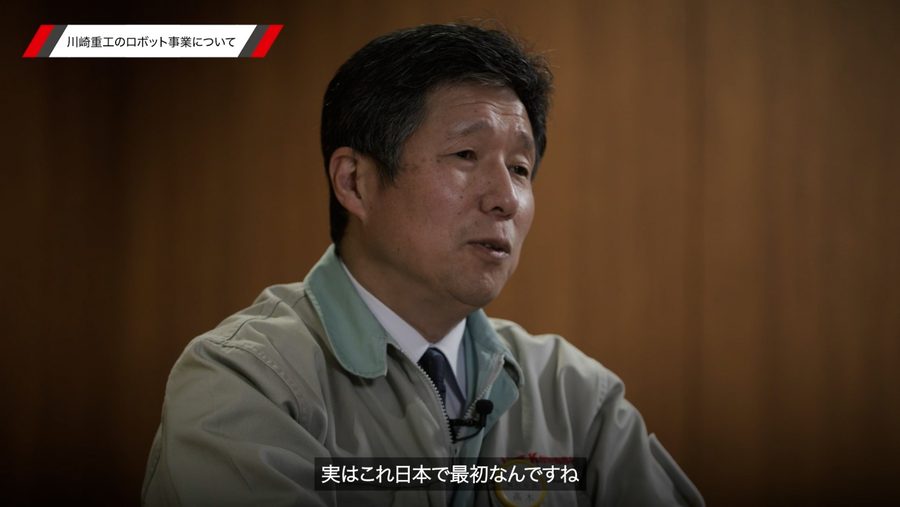
ー Kawasaki Heavy Industries is a comprehensive engineering company. Is there synergy with any of the other companies?
Noboru Takagi:
Kawasaki factories manufacture a variety of products. For this reason, there are many cases where robots are used in the manufacturing sites of other Kawasaki companies. As the equipment comes from within the group, this enables us to take on new challenges such as working on automation, even if it will require a long time. In addition, compared with external customers, the employees at our own sites will give us much franker comments, including sometimes quite harsh opinions.
I feel that this gives us an advantage that other companies do not have.
Our company also has a Corporate Technology Division at our head office, and the technologies of all the Kawasaki companies are gathered there. This is why it is possible for us to utilize the technology of other companies in our robot development.
ー It seems that there is a growing need for robots in all fields due to the coronavirus crisis. How will Kawasaki proceed with the implementation of robots in society from now on?
Noboru Takagi:
In the near future, the working population of Japan will decrease due to the low birth rate and aging population. The needs for robots for labor saving and automation will definitely increase from now on.
However, there are still many fields where robots have yet to be implemented in society. The key phrases regarding the social implementation in those fields will be “human collaboration,” “skill transfer,” “teaching” and “production of diverse products in small quantities.”
The first of these is “human collaboration.” In the past, in order to use a robot, it was necessary to enclose the robot in a safety fence and prevent people from entering inside. This need to secure a large space exclusively for the robot was a challenge for their introduction.
For that reason, having collaborative robots that can coexist with people and can work next to people will be the key to the spread of robots. The question is how far we can improve efficiency while also ensuring the safety to be able to have collaboration with people. This is why we proposed duAro, the dual-arm SCARA robot I mentioned earlier.
The second theme is converting tasks that require human skills, senses, and judgment into robot work. To tackle this, Kawasaki is proposing a technology called Successor, which enables a person to move a robot by operating a tool called the Communicator remotely.
As operation is possible remotely, it is also possible to free people from work in workplaces with labor that is dirty, dangerous and demanding.
Another merit of Successor is that one worker can operate multiple robots. It is not necessary to remotely control everything done by the robot. When the task is something that the robot is good at, it can be automated with teaching as normal. The human worker needs to assist only when the task is difficult, or when the robot has made a mistake. It is possible to combine such automatic operation and remote control. This makes it possible for one person to support multiple robots in a factory from an office, which could be a new way of using robots.
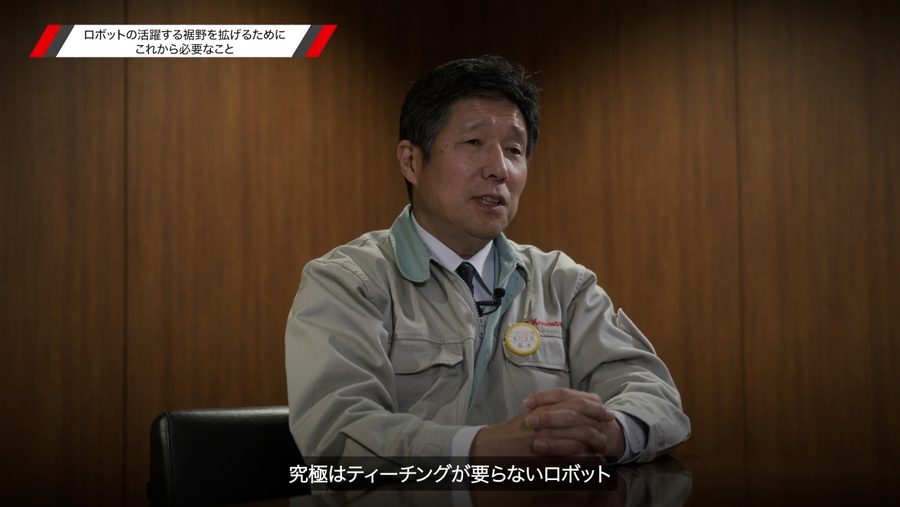
Noboru Takagi:
The next theme is the “teaching,” where the robot is programmed how to move. Up until now, teaching has been conducted by using a teach pendant. However, these are difficult to operate and also it is necessary to perform the teaching each time.
It is also possible to use the Successor we are proposing to simplify teaching as much as possible.
Once the robot has been moved by remote control, it remembers those movements, so it can reproduce the human movements as they are and the robot can perform the task automatically from the next time on. In other words, the teaching has been completed.
The final theme is support for the “production of diverse products in small quantities.” There are growing needs for product customization and the lifecycle of products is getting shorter. To meet those needs, it is necessary to change the production line each time. However, once a robot has been installed on a production line, it becomes inflexible. As a result of that, it was becoming necessary for human workers to perform the work.
So, if that is the case, let’s make it possible to move the robot. That is the thinking behind Kawasaki’s development of TRanbo. The robot is equipped with a travel function and can be moved by the robot controller. By making it possible to move the robot flexibly, I think we will be able to accelerate the spread of robots in all fields.
ー With respect to the robot itself moving, there is also Nyokkey.
Noboru Takagi:
Nyokkey is a robot that can move around town like a human and perform work with its arms. We plan to perform proof-of-concept at Future Lab HANEDA in Haneda Innovation City. The plan is to first open a robot restaurant and perform work such as serving meals, clearing tables and cleaning. I have great expectations that Nyokkey will be able to work in various scenes in the real world in the future.
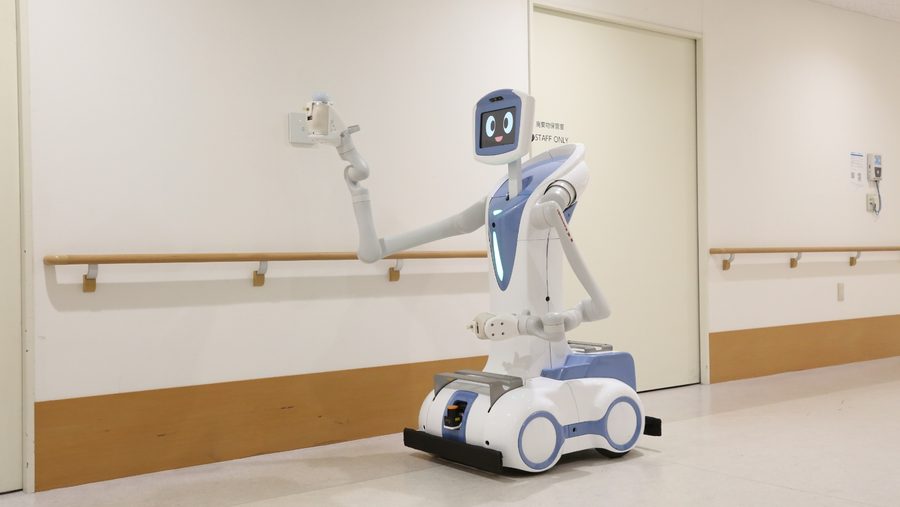
ー It looks like robots are going to be more integrated into our lives. The Kawasaki’s humanoid robot Kaleido is also getting upgraded each year. Will it be implemented in society in the future?
Noboru Takagi
I’m sure that day will come. We have received specific inquiries from several companies and are now about to enter the demonstration testing phase.
I think the ultimate automation by robots is humanoid robots. This is because everything in the world is geared toward humans doing things. Not even a six-axis articulated robot can move in the same way as a human. If you try to automate what humans are doing by copying it exactly, you will absolutely need a humanoid robot.
I am hopeful that Kaleido will play an active role in workplaces with labor that is dirty, dangerous and demanding, and in the sites of disasters. Another expectation is where there is a particularly harsh working environment in a manufacturing site. It would be good if Kaleido played an active role in such places.
Digital platform to promote the social implementation of robots
ー DX (Digital Transformation) is currently progressing in society as a whole. Please tell us how Kawasaki will use DX in automation by robots.
Noboru Takagi:
Kawasaki is also currently working actively on DX. The advantage of DX is that data can be shared and utilized.
We are currently building a digital platform called ROBO CROSS. We are aiming for an open platform where, in addition to Kawasaki, there is also participation from customers and various parties in the robot engineering chain such as integrators, vendors and suppliers.
I believe that making the data and applications gathered there freely available for use will promote the social implementation of robots.
For example, it will become possible to conduct system design easily by utilizing the existing robot-related design data. In addition, after robots are shipped, continuously collecting data via ROBO CROSS will make it possible to issue inspection alerts according to the degree of wear.
Finally, the most significant merit is simulations using digital twins. It is possible to simulate things like the interference checks, cycle time, and motion time on ROBO CROSS and then to conduct the implementation in the field in that state.
In the past, even though we conducted consideration in advance, it was still necessary to conduct repeat checks and fine adjustments in the field. Therefore, we believe that the expansion of this platform will lead to a reduction in the time required for the introduction of robots.
We want to hear customers ask, “Is Kawasaki doing this?”
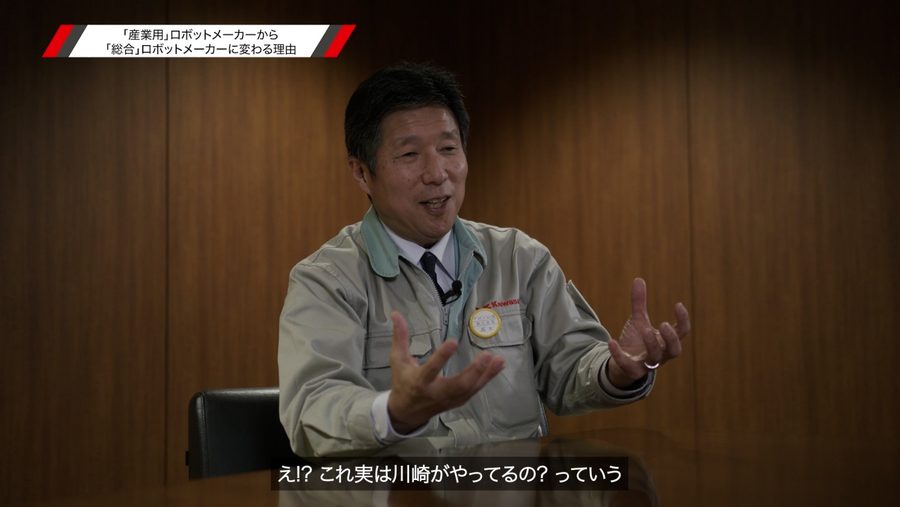
ー Lastly, please tell us about your vision for the future.のビジョンについてお聞かせください。
Noboru Takagi:
Up until now, Kawasaki has focused all efforts on the introduction of robots to factories that are manufacturing sites. That will continue, of course, but I also want us to go out from the factories into the towns, and to become able to contribute to society as a whole.
The realization of the ROBO CROSS I just explained will be a great leap forward for Kawasaki as a fully integrated robot manufacturer. I believe in that.
There are platforms in the world in areas we haven’t yet had much contact with, such as agriculture, forestry, and fishing. Collaboration between those platforms and ROBO CROSS will make it possible for us to benefit from each other, and I think that will lead to the expansion of robots from the manufacturing industry into other fields.
I want to connect with various industries in that way, and finally to connect with individuals. I think it will be in the form of B to B to C, with a situation where individuals are using Kawasaki’s technology without knowing it. We call it “Kawasaki Insight,” and we want to hear the customers say, “Oh, is it actually Kawasaki doing this?” That is my personal dream.